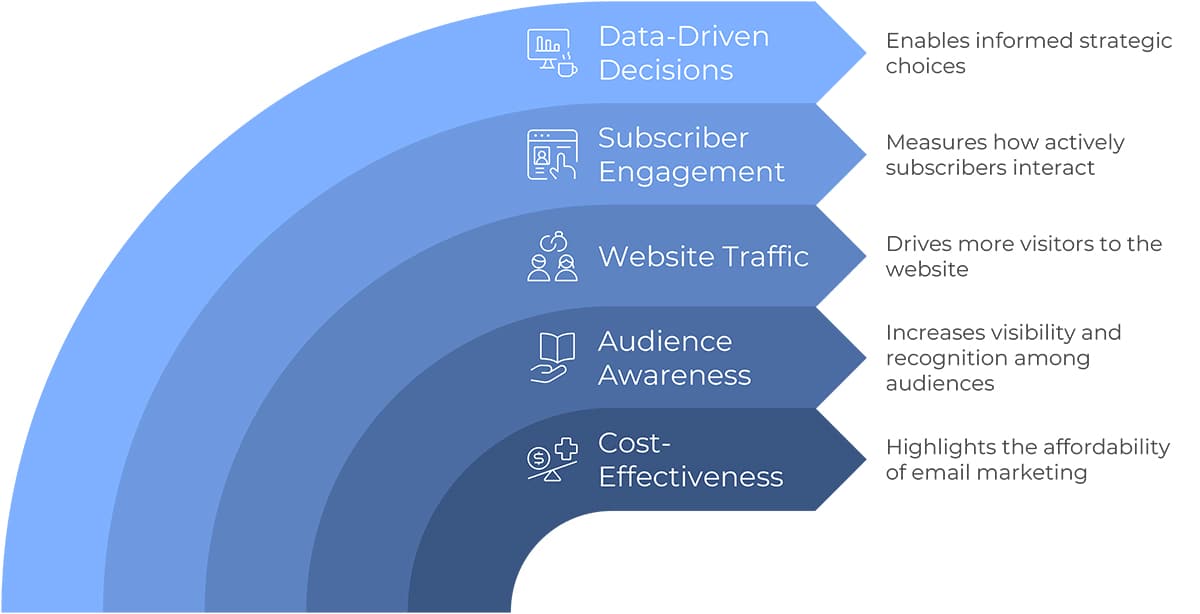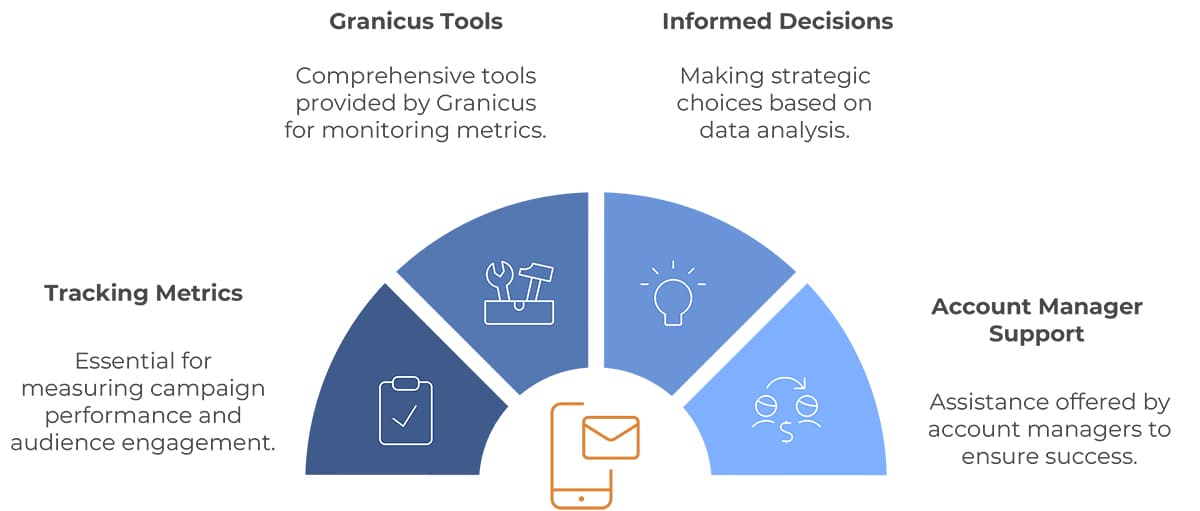Why track email marketing campaigns?
Email marketing is one of the most cost-effective ways to communicate with your audience. It boosts awareness and website traffic while also providing invaluable insights into subscriber engagement. By tracking campaign performance, you can make data-driven decisions that align with your organization’s goals. Regular email reports offer an overview of how well your strategies are working, helping you identify areas for improvement.

The advantages of tracking email marketing campaigns
Keep reading for a comprehensive overview of the top email reporting metrics every organization should monitor for success.
Key metrics to monitor
1. Open Rates
Open rate measures the percentage of recipients who opened your email compared to the number who received it. To record an open, the embedded web beacon in your email must be rendered. This web beacon is a tiny 1×1 pixel image automatically included in your sent email. Each subscriber receives a unique web beacon, which must be downloaded for the email to be marked as opened. Web beacons are the industry standard for tracking email open rates. Email open rates are calculated as follows:
Open Rate = (Total Emails Opened / Total Recipients – Emails Bounced) x 100
A good benchmark for open rates is around 20-30%, which can vary based on industry. Tracking open rates over time allows you to assess the effectiveness of your subject lines and overall email content.
Read more on tracking open rates in the Granicus Support Portal.
2. Click Rates
Click rates indicate how many recipients clicked on links within an email. This metric reflects the effectiveness of content in driving action.
Click Rate = (Number of Unique Link Clicks / Number of Emails Delivered) x 100
Aim for a 5% click rate—anything over 8% is outstanding. Enhancing your content and designing clear calls-to-action can significantly boost this metric.
3. Conversion Rate
The conversion rate measures how many recipients took the desired action, such as making a purchase or filling out a form.
Conversion Rate = (Total Conversions / Total Recipients) x 100
Implementing A/B testing can help you determine what resonates best with your audience, leading to higher conversion rates.
4. Unsubscribe Rate
This metric shows the percentage of recipients who opted out of your email list.
Unsubscribe Rate = (Number of Unsubscribes / Total Emails Delivered) x 100
A rate around 0.2% is ideal. Analyzing unsubscribe trends can help you gauge audience satisfaction and adjust your content strategy accordingly.
5. Bounce Rate
Bounces occur when emails cannot be delivered. Hard bounces indicate permanent issues (such as non-existent email addresses), while soft bounces are temporary (such as full inboxes). Regularly cleaning your mailing list helps maintain a healthy bounce rate.
Bounce Rate = (Number of Bounces / Total Emails Sent) x 100
6. Delivery Rate
This metric reflects the percentage of sent emails that successfully reach inboxes without bouncing. Selecting dedicated email providers with best-in-class deliverability and IP addresses dedicated exclusively to government delivery ensures the highest deliverability possible. The most reputable email service providers will help you achieve high deliverability rates through setting up SPF, DKIM, and DMARC, which help authenticate email senders by verifying they came from the domain they claim they are from.
Delivery Rate = (Total Emails Sent / Number of Emails Delivered) x 100
Strive for a delivery rate above 95%. Using reputable email service providers and maintaining a clean list can help achieve this. Additionally, implementing best practices around subscriber suppression will reduce churn rates by enforcing the use of subscriber contact preferences.
Read more on tracking delivery rates in the Granicus Support Portal.
7. Churn Rate
Churn rate shows how much a specific topic subscriber list is growing or shrinking after accounting for unsubscribes and bounces. This is an area you’ll need to continually focus on to add new subscribers to maintain your list size.
Start monitoring your communication metrics
Tracking these essential email metrics can significantly enhance your campaign performance and drive your audience to take action. Granicus offers comprehensive tools to monitor these metrics, allowing you to make informed decisions and optimize your communications strategies. Our account managers are here to assist you every step of the way, ensuring you achieve the best results possible. Start leveraging your email reporting metrics today to optimize your communications strategies!

Optimizing your communications strategy
“At the end of the day, we're the voice of the people. We want to keep them informed and let them know resources that are available to them. Now we're reaching more people than we ever would have before.”
Paige Bridges
Communications Coordinator, Utah House of Representatives








